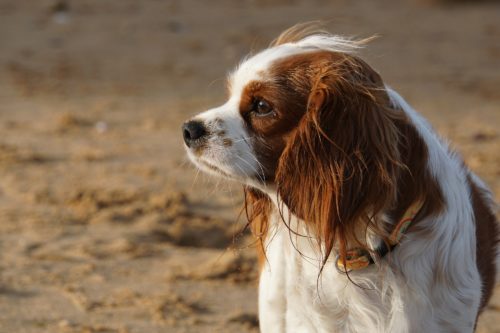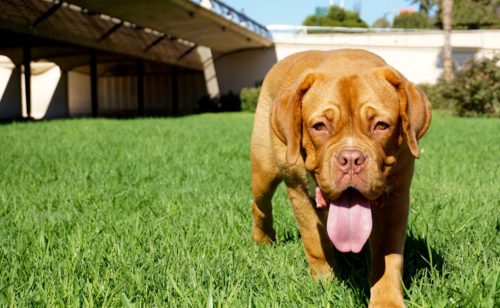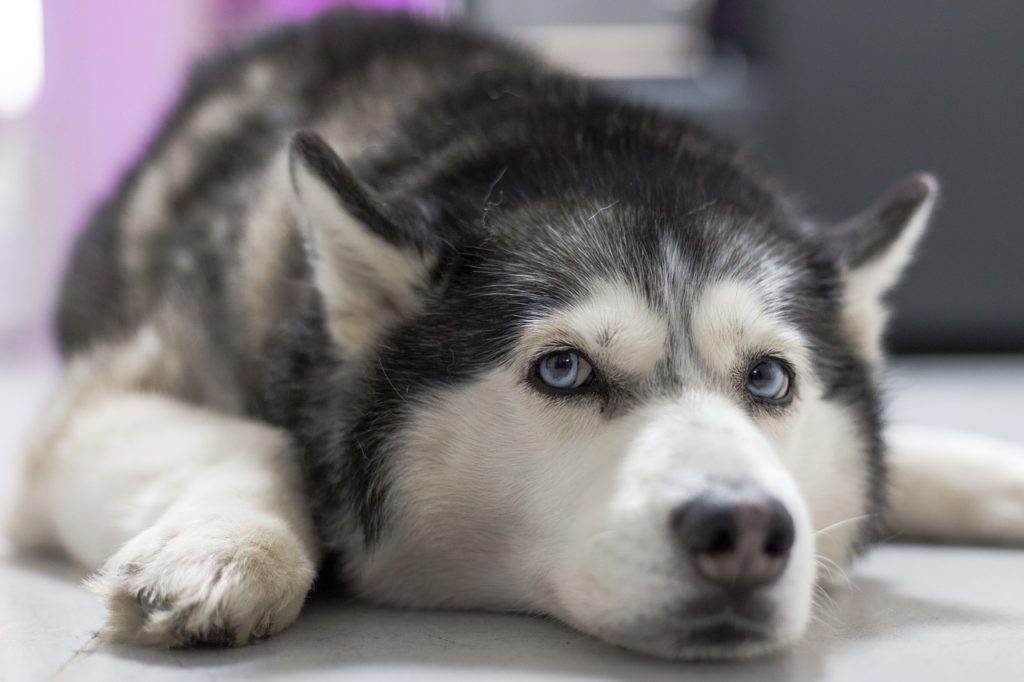As with humans, dogs can develop what is known as a hernia. However, since this problem is entirely internal in nature, it can be difficult to detect or know that your dog is suffering from a hernia. Therefore, it is important to know the signs and symptoms of a hernia in dogs as they are extremely painful and can be dangerous. If you believe your dog is suffering from a hernia, take him to the vet immediately for a comprehensive evaluation. So, what is a hernia and how can you know if your dog has one?
What Is a Hernia?
A hernia is developed when an organ, or some fatty tissue, protrudes through a weak spot or tear in surrounding muscle or connective tissue known as fascia. While hernias are completely treatable, depending on the type, they can be life-threatening to canines. The five most common types of hernias in dogs are umbilical, inguinal, diaphragmatic, perineal, and hiatal.
- Umbilical: The most common type of hernia in dogs, an umbilical hernia is congenital and most often seen in puppies. With an umbilical hernia you will notice that your dog’s belly button has been replaced by a squishy protrusion. Depending on the size of the hernia, it may heal on its own. If not, it can be surgically fixed when your puppy is spayed or neutered. However, if large enough, failure to repair the hernia can lead to serious complications.
- Inguinal: Occurring in the “groin” area where the inner fold of the rear leg attaches to the body wall, these hernias can vary in size from small to large. If the opening is large enough, portions of the intestine, bladder, or uterus can become trapped within the hernia which can cause a life-threatening problem. These hernias are considered congenital and often affect middle-aged female dogs, particularly those who are pregnant. An inguinal hernia should be immediately addressed with surgery to avoid complications.
- Diaphragmatic: The muscle that separates the abdominal organs from your dog’s heart and lungs is called the diaphragm. A hernia in the diaphragm means the abdominal organs begin to enter the chest cavity, making it difficult for your dog to breath. These hernias can either be congenital or the result of an injury, such as being hit by a car.
- Perineal: Some breeds are predisposed to this type of hernia, and it commonly occurs in unneutered male dogs over the age of 5. A perineal hernia occurs when the muscles of the pelvis tear and the abdominal organs enter the area adjacent to your dog’s anus.
- Hiatal: This type of hernia develops when a portion of the stomach pushes into the diaphragm, where the esophagus joins the stomach. Hiatal hernias can be congenital or the result of trauma.
Regardless of the type, you should take your dog to see a vet if you suspect the presence of a hernia. As you can see, the complications of most hernias can be life-threatening if left untreated.
Signs & Symptoms of Hernias in Dogs
But how can you tell if your dog has developed a hernia? Signs of a hernia vary depending on the location and severity of the hernia. In many cases, with a small uncomplicated hernia, you may not even notice anything or simply feel a protruding, soft, and bubble-like mass in the region of the belly button or groin. As the hernia becomes larger, and more vital organs are compromised, signs may include:
- Pain
- Vomiting
- Lack of appetite
- Difficulty urinating
- Coughing
- Difficulty breathing
- Irregular heartbeat
- Large mass in the abdomen or groin
Causes of Hernias in Dogs
Many hernias are congenital, meaning your dog was born with the abnormality or acquired through trauma, disease or aging. Congenital hernias are the most common cause of hernias, especially in young dogs and puppies. They may be the result of a spontaneous problem during development or a genetic defect passed on from a parent.
Trauma is also a common cause of hernias among dogs of all ages. Blunt force trauma, such as being hit by a car, or any sort of blow to the body wall can cause a tear in either the abdominal wall or the diaphragm which allows abdominal organs to herniate.
Diagnosis
If you suspect your dog has developed a hernia, your veterinarian has a number of tools at his disposal to confirm whether or not you are correct. Umbilical and inguinal hernias can typically be diagnosed by palpating, touching with slight pressure, the abdomen or groin during a physical exam. However, further imaging may be needed to confirm the progression of the condition and whether any vital organs such as the intestines or other abdominal organs are protruding through the herniated section of the muscle or fascia. For hernias that open into the chest cavity, such as diaphragmatic or hiatal, imaging studies such as x-rays and ultrasound will be required to make the same determination regarding the displacement of organs in those spaces by the hernia and to what extent.
Treatment for Hernias in Dogs
All hernias will require surgery in order to repair the muscle wall which has been torn. During surgery, your veterinarian will replace the contents of the abdomen and repair the defect so the organs remain where they are supposed to be moving forward. The surgery can be challenging depending on the size of the tear, whether or not organ damage was sustained when they were herniated, and the overall health of your dog.
Surgical Procedure
Prior to surgery, you will be required to keep your dog off food for at least 12 hours to lessen the chance of nausea associated with certain anesthetic premedication agents.
While some hernias, such as perineal, may not require an abdominal exploration, other repairs are much more complex, like diaphragmatic or hiatal, and involve the abdominal and thoracic cavities. In general, the steps of a hernia repair will look something like this:
- Pre-anesthesia and anesthesia medications administered.
- Position the animal for surgery – on his back for abdominal or thoracic hernias and on his stomach for perineal hernias.
- Prepare the incisional area by shaving and cleaning the skin.
- Move into the operating room if preparation was completed in a separate room.
- Place drapes for surgery to protect and help keep the operating field clean.
- Sterilize the skin which will be incised.
- Make an incision along appropriate plane for the specific type of hernia.
- Identify, also known as visualization, the hernia and remove any necrotic, or dead, tissue from around the wound.
- Repair the defect in the muscle layers by stitching it back together. A mesh patch may be used to help repair large tears.
- Check the abdomen, or other surrounding cavities, for bleeding.
- Close the Incision.
Due to the extent of the surgery, hernia repair surgery can be quite expensive and the exact price will vary depending on the location of the hernia and the cost of living in your area. Typically, hernia repair expenses range from $700, for less complex and common hernias, to $2,500 for more complex cases. The average cost of a canine hernia repair is about $1,600 including diagnosis, surgery, and aftercare.
Hernia surgery can be a lifesaving procedure with long lasting benefits. Following a repair, the potential for another hernia occurrence in the same location is low.
Complications
As with all surgeries, hernia repair has some associated risks. The most common of these risks include bleeding, dehiscence (rupture of the incision), and infection. It will be imperative to keep your dog calm and still after surgery to help prevent these adverse effects. You will need to monitor your dog for signs of these risks and keep an eye on the incision for signs of infection or rupture. Signs of infection include fever, redness of the incision, the incision may be warm to the touch and there may be some discolored drainage. Notify your vet immediately if any of these symptoms are present.
Further steps can be taken to mitigate the possibility of complications. Cases of small umbilical hernias, where only fat is protruding through the wound, are particularly common among puppies. In these cases, your vet will likely recommend repairing the hernia at the time of spay or neuter to avoid multiple surgeries. If, however, your adult dog has developed a small hernia your vet will recommend immediate repair to avoid further tearing in the muscle wall.
Similarly, large hernias should also be repaired as soon as possible to avoid life-threatening complications such as permanent organ damage or even death. Such complications are especially common when the hernia contains vital organs of the abdominal or thoracic cavities. Your veterinarian will examine your dog and determine the best course of action.
Hernia Prevention
When it comes to congenital hernias, it is impossible to predict when or where they will occur. Although, some specific breeds are thought to be predisposed to developing certain types of hernias. Shar-Peis and English Bulldogs, for example, are more likely to have a hiatal hernia than other breeds while Weimaraners are more prone to diaphragmatic hernias. If your pet has a congenital hernia, it is best to avoid breeding in order to prevent the defect from being passed on.
Although hernias can be distressing for both your dog and yourself as you see him suffer, it is important to remember that they are treatable. The majority of dogs who receive prompt diagnosis and early intervention go on to live long and healthy lives. If you discover a spontaneous swelling or mass on your dog, get it examined by a veterinary professional as soon as possible – even if it does not seem to be bothering your pet. Early diagnosis is the key to excellent outcomes.
Sources:
- “Hernia in Dogs.” Pet Health Network, Accessed 28 Feb. 2018. www.pethealthnetwork.com/dog-health/dog-diseases-conditions-a-z/hernia-dogs.
- “Hernia in Dogs – Symptoms, Causes, Diagnosis, Treatment, Recovery, Management, Cost.” WagWalking, 25 Jan. 2016, Accessed 28 Feb. 2018. www.wagwalking.com/condition/hernia.
- “Hernia (Inguinal) in Dogs.” PetMD, Accessed 28 Feb. 2018. www.petmd.com/dog/conditions/muscokeletal/c_dg_dog_hernia_inguinal.
- “Umbilical Hernia in Dogs.” PetMD, Accessed 28 Feb. 2018. www.petmd.com/dog/conditions/musculoskeletal/c_dg_umbilical_hernia_in_dogs.
- “Symptoms of Hernias in Dogs.” Petwave, 15 Aug. 2016, Accessed 28 Feb. 2018. www.petwave.com/Dogs/Health/Hernias/Symptoms.aspx.




